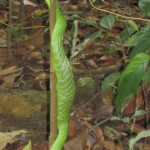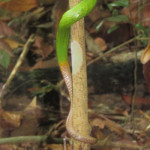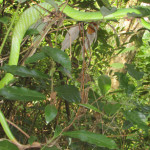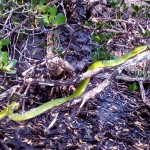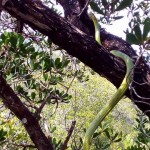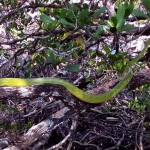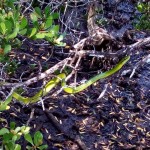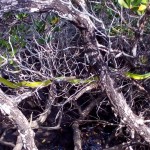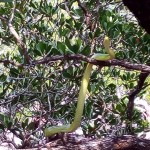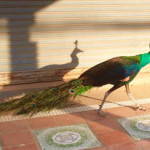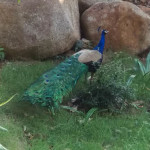Thiania bhamoensis
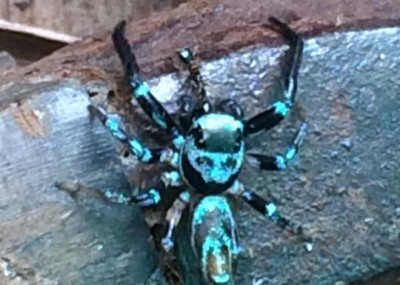
Image Copyright Hans Henrik Hansen
Last Observed: January 2016 – Koh Chang
Observed By: Hans Henrik Hansen
Thiania bhamoensis is a small and brilliantly blue and black coloured little species of jumping spider.
These spiders build lairs by using their silk to bind two green leaves together. They build these nests on many species of plants but most commonly on the aptly named spider lily.
In Southeast Asia these spiders are also known as the fighting spider because two males will always fight each other when placed in close proximity. So of course people fight them for sport – you’d think there would be something better to do – but never make the mistake of overestimating human nature.
Thiania bhamoensis Wikipedia
Silvery Langur (Trachypithecus cristatus)
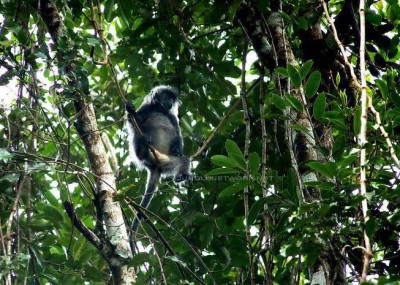
Image Copyright Suthanai Krupanich
Last Observed: Koh Chang, January 2016
Observed By: Suthanai Krupanich
The silvery langur is an arboreal (tree dwelling) primate native to Peninsular Malaysia, Sumatra and Bornea (according to Wikipedia), and Koh Chang (as this photo shows).
It is also known as the silvery lutung or the silvered leaf monkey.
It’s coat is dark brown or black with distinctive silvery grey tips. It is a herbivore and has a unique three-chambered stomach that allows it to digest the cellulose in its diet in a similar way to the four chambered stomach of cows. In fact pretty much all it eats is leaves and it has specialised to inhabit the middle canopy of forests, leaving the upper layers to fruit eating primates.
The silvery langur is not yet endangered but you will be very lucky to spot one on Koh Chang. Unlike it’s enterprising cousin the crab-eating macaque it stays deep in the protection of the jungle.
Silvery Langur Wikipedia
Red-Tailed Racer (Gonyosoma oxycephalum)
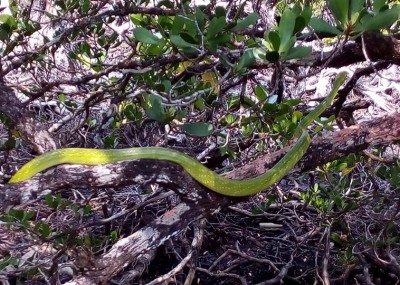
Image Copyright Teerasak Thomas Suamcheepmasau
Last Observed: Jan 2016, Koh Chang
Observed By: Teerasak Thomas Suancheepmasau,Paul Dunn
The red-tailed racer is a species of ratsnake native to Koh Chang. It is also known as the red-tailed green ratsnake but red-tailed racer is way cooler so that’s what we’ll call it here.
This is a large and powerful snake. The female is larger than the male and can reach lengths of up to 2.8 metres. They live up to 20 years in captivity.
They live in trees and seldom come to ground. They feed almost exclusively on birds, bird eggs and bats, which they catch in mid-flight whilst hanging from branches.
They are a non-venomous snake but can still be aggressive and give a nasty bite.
Red-Tailed Racer Wikipedia
Image Copyright Paul Dunn
Image Copyright Teerasak Thomas Suamcheepmasau
Blue Peafowl (Pavo cristatus)
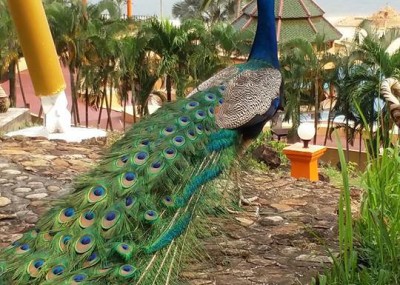
Oksana Babchenko
Last Observed: January 2016 – Koh Chang
Last Observed By: Oksana Babchenko, James perkins, Moni Von Bauer
The Blue or Indian Peafowl is easily distinguished from its close relative the green peafowl because the male is blue and not green. Given some of the identification challenges you come across this is an absolute walk in the park.
We all call them peacocks but that term strictly only applies to the male, the female being a peahen and the species as whole being called peafowl.
Anyway they are surely one of the world’s best known, beautiful and most distinctive birds and you probably know all about them already. But for those who don’t it is the male of the species that has the huge fan of bright feathers which it uses for display to attract a mate.The female is acomparatively drab brown and white colour.
Koh Chang has quite a few peafowl and it isn’t clear, to me at least, whether they are native to the island or have been brought in to decorate resorts such as Chang Park in Kai Bae. Whatever the fact they are native to this part of the world and are quite comfortable with Koh Chang as a habitat.
Blue Peafowl Wikipedia
Image Copyright James Perkins
Image Copyright Moni Von Bauer
Pacific Swallow (Hirundo tahitica)
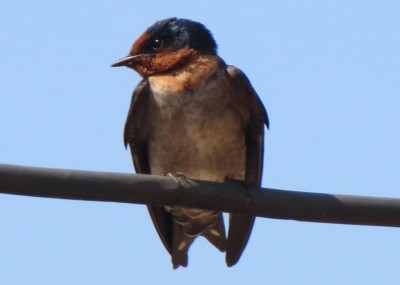
Image: Dave Hinchliffe

Image Copyright Gerardo Messere
Last Observed: April 2016 – Koh Chang
Last Observed By: Gerardo Messere, Dave Hinchliffe
The Pacific Swallow is a small member of the swallow family that breeds in south and southeast Asia and the South Pacific.
It grows only to about 13cm in length and has a blue and greay back and wings and a red throat.
Like other swallows it is a fast flier and feeds on insects whilst in the air.
Pacific Swallow Wikipedia
Micronia Aculeata
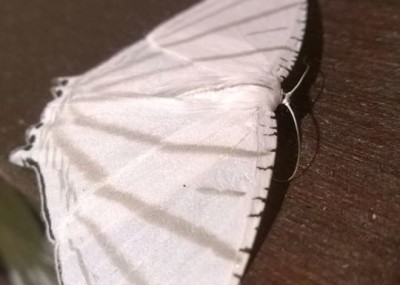
Image Copyright Napha Kotkangplu
Last Observed: February 2016, Koh Chang
Observed By: Napha Kotkangplu
Okay let’s be honest here. This moth might not actually be micronia aculeata, a moth that is apparently found in India and Sri Lanka. Hard to tell though, it certainly looks extremely similar so at worst it’s a very close relative. And the internet has so much different and often contradictory information that identifying animals – particularly insects – extra particularly butterflies and moths is a nightmare. So it’s Micronia aculeata until an expert tells us otherwise. Okay?
Micronia Aculeata Wikipedia
Masked Hunter (Reduvius personatus)
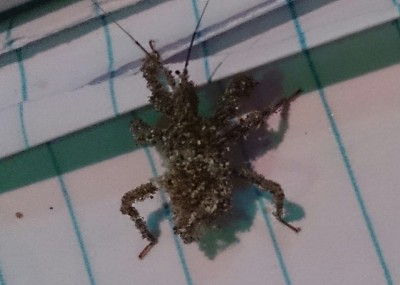
Image Copyright Lena Abi Chaker
Last Observed: February 2016, Koh Chang
Observed By: Lena Abi Chaker
The masked hunter is a small predatory member of the assasin bug family of insects. It’s another of those “you won’t believe it animals” that Koh Chang seems to specialise in. The photograph isn’t blurred, oh no. The sneaky masked hunter camouflages itself by covering its shell with dust, dirt and small particles of matter. Then it pounces on its unsuspecting prey ot woodlice, lacewings and other smaller insects. It also eats bedbugs in case you require a redeeming feature.
They apparently have a very painful bite which they can use in self defense – but fear not there’s no poison – for a change.
Masked Hunter Wikipedia
King Cobra (Ophiophagus hannah)
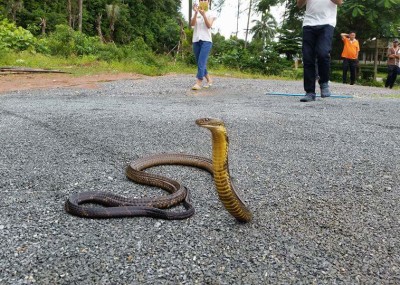
Image Copyright Stian Giordano Dahler
Last Observed: 2014
Observed By: Hans Goossens
The infamous, magnificent king cobra is the world’s longest species of venomous snake, growing in rare cases to nearly six metres in length. It isn’t that closely related to other species of cobra and instead is the sole member of its own genus.
The king cobra feeds mainly on other snakes. So if you see one you can make a fair guess that there are other snakes nearby. They are probably hiding though.
The snake is predominantly a grey-green colour with a paler belly but can also be tan or even black in colour. Juvenile snakes are totally different in appearance though being black with yellow bands across. They can be confused with the banded Krait but are distinguishable by their characteristic hood.
King cobras locate prey with an extremely attuned sense of smell, keen eyesight and a sensitivity to small vibrations in the earth.
Dangerous?
King cobras have a highly toxic venom that they inject in large quantities when they bite. And they react very aggresively when they feel threatened, adopting the characteristic cobra hood and rearing stance that displays a preparedness to strike.
But studies have revealed that their first instinct is to avoid confrontation and cases of king cobra bites are surprisingly rare, particularly so since it is so frequently encountered by people.
One piece of good advice when confronted by a provoked and aggresive king cobra is to slowly remove a hat or other piece of clothing and toss it to the ground while backing away. Then a change of shorts might be in order.
King Cobra Wikipedia
Jewel Beetle (Chrysocroa fulgens)
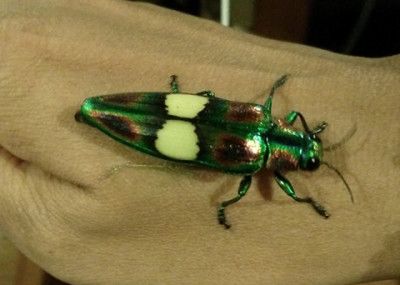
Image Copyright Paweena Khamsap
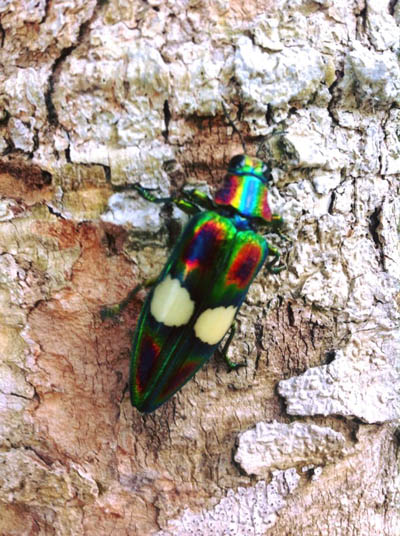
Image Copyright Nattapol Phutong
Last Observed: February 2016, Koh Chang
Observed By: Paweena Khamsap, Nattapol Phutong
The Jewel Beetle family are also known as the metallic wood boring beetles. Both names refer to their incredible iridescent shell which has a brilliantly coloured metallic sheen, and in the case of this species two ivory-coloured spots on the back.
Jewel Beetle Weevil Coleoptera-Atlas.com
Indo-Chinese Rat Snake (Ptayas korros)
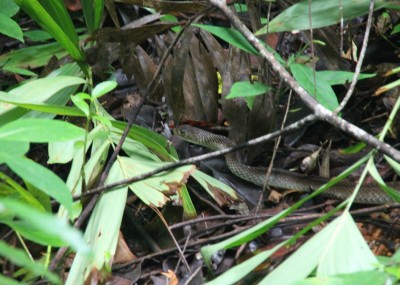
Image Copyright Hans Goossens
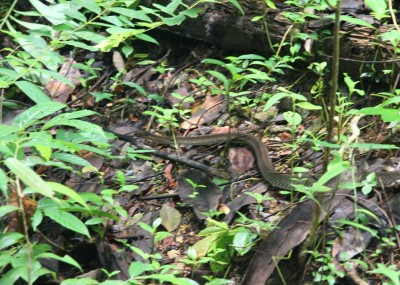
Image Copyright Hans Goossens
Last Observed: February 2016
Observed By: Hans Goossens
The Indo-Chinese Rat Snake Rat Snake, A.K.A. Chinese ratsnake is a nonvenomous snake from the colubrid family. It can grow to a length of 1.7 metres.
Indo-Chinese Rat Snake Wikipedia




